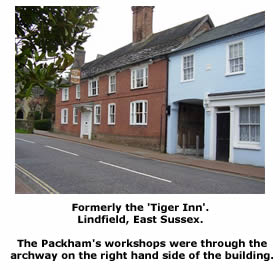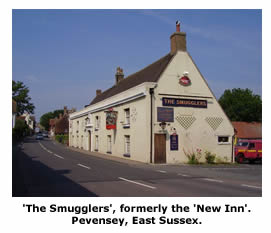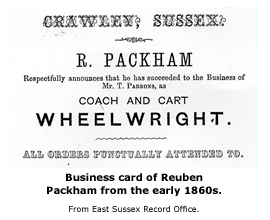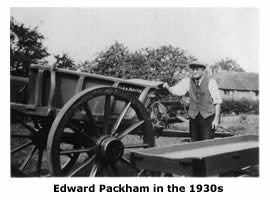
My great x3 grandfather, Henry Packham, was born in 1804, the son of a farmer from Clayton in Sussex. Henry was the first of four generations of wheelwrights, and is said to have left his father`s farm after a disagreement and moved to Lindfield where he earned enough money to buy an apprenticeship in a wheelwright and carriage building business.
In 1828, Henry married Martha Burry in Hurstpierpoint. The earliest record I can find of Henry in Lindfield is in the 1832 Pigots Directory of Sussex, in which he was described as a wheelwright.
Henry and his sons Reuben (my great x2 grandfather) and Charles ran their wheelwright and carriage building business at the ‘Tiger Inn’ next to the parish church.
Martha died of smallpox in 1844 and Henry remained a widower until 1849, when he married Ann Smith, a widow from London, who moved in with the Packham family, with her two children.
Reuben met his future wife, my great x2 grandmother, Mary Ann Baker, and as she had an illegitimate son and was seven months pregnant at the time of their marriage in April 1857, Henry disapproved of their union, which consequently led to father and son going their separate ways.

Henry sold the ‘Tiger Inn’ and bought an inn in Crawley. However, his second wife Ann was a demanding woman with expensive tastes, which forced him out of semi-retirement, to buy the ‘New Inn’ in Pevensey, Sussex, just east of the castle, and to continue his wheelwright’s business. This is now ‘The Smugglers’ pub and restaurant, and on my last visit I found an outbuilding, which could possibly have been his workshop.
Being near the coast led Henry to become involved in smuggling and he is said to have hidden bottles of French gin from the excise men under rhubarb leaves.
However, their life in Pevensey was to be short lived, as Henry died of dropsy on 1st April 1858, aged just 54 years. He is buried in the churchyard at St Nicholas church. I cannot trace Ann Packham after this date, although she is said to have sold up and returned to London.
Charles’ son William later described his grandfather as “6ft tall and well built, a born woodworker and tradesman.”
Meanwhile, Reuben, his wife Mary Ann and children, together with his brother Charles, left Lindfield for Horsted Keynes where they worked as wheelwrights. In the early 1860s Reuben took over the running of a wheelwright’s business in Ifield near Crawley, which was on the London to Brighton coach route. In 1863 they moved to the ‘Plough Inn’, in Splaynes Green, just north of Fletching, where Reuben continued his wheelwright’s business from a workshop he built himself.
The 1874 Post Office Directory of Sussex described Reuben as a wheelwright and beer retailer.

After his marriage in 1864, Charles left Splaynes Green and took over the running of a wheelwright’s business at the ‘Foresters Arms’ in Fairwarp.
After spending some time in London and a number of years in America in the 1870s, he returned to Sussex where he worked as a carpenter.
Reuben John Bannister, the blacksmith at the local forge, died in 1880, and the Maryon Wilson family of the nearby Searles estate bought the property, and extended and improved it by building a family house and a travis where the horses were to be shod, with the Packhams already secured as tenants.
The family moved their wheelwright’s business to the forge and Reuben’s ‘big paint shop’ where he built the carriages right through to the upholstery and paintwork, was moved along the road by rollers and placed in the yard.
The new premises provided the family with much more space to build and repair wagons, carts, carriages and landaus, and they built a large wheelwright’s shop, with five work benches placed around the sides, which held their tools. At one end of the shop there were two large doors which opened out onto the yard, so that wagons and dung carts could be pulled in and out. There were windows, but no heating, and an earth floor which was usually covered in wood shavings. Reuben’s granddaughter can remember the square ‘horse’ where the hub of a wheel, with the spokes already attached, was placed so that the felloes (curved segments) could be fixed around the sides to form the rim, and an oil stone for sharpening chisels etc. She has described the workshop as an ‘Aladdin’s Cave’ of wheelwright’s equipment.
The travis, where the horses were shod, can be seen on the postcard opposite with one of the large doors open. The door to the left was the fuel store for the forges, and above this was a large room, which was used as a timber store.

The blacksmith’s shop, which cannot be seen in the photograph, lay between the house and the travis. There were originally five forges in there, but in later years fewer of them were used. Reuben’s granddaughter can remember, as a child in the 1920s, watching the sparks flying as the red hot iron was hammered into shape on the anvil.
Behind the blacksmith’s shop, in the yard, were two large grindstones fixed on iron supports, for sharpening the tools. A large brick kiln for heating the iron hoop tyres for the wagon, cart and carriage wheels stood in the yard, and next to this was the round iron platform where the wheels were placed for tyring. Also in the yard were stacks of timber (mainly oak) cut into planks and kept off the ground and protected by corrugated iron sheets, as well as a saw pit where larger pieces of wood were cut up.
At the side of the house there was a shop where the family sold pitch forks, garden forks, spades, hoes, swap hooks, nails, screws etc. They also sold ploughs, harrows, horse drawn hay cutters, hay rakes and binding machines. They would also repair and replace parts for any of these. Originally they would have made these themselves, but unable to compete with mass-produced, factory made tools, they would later just stock these in their shop.
The family continued to run the ‘Plough Inn’ until the mid 1890s. The 1882 Kellys Directory of Sussex describes Reuben as a coachbuilder, wheelwright, smith, agricultural implement maker & beer retailer.

Reuben died of pneumonia in 1888, aged 53, and Mary Ann was left to run the business with her sons. You can read more about her story in my article ‘The Matriarch’ in the March issue of the magazine.
By the early 1900s, the wheelwright and blacksmith’s business at the forge was being run by my great x2 uncles, Alfred and Edward Packham. My great grandfather, Abraham, and his half brother, John, worked for them as blacksmiths.
By the mid 1930s, Alfred, John and Abraham had all died, and Edward lived at the forge with his family, including his only son, Frank, who he had taught to be a wheelwright. Both had taught themselves motor mechanics and were regularly called upon to make repairs to motorised vehicles.
In World War Two, Frank went to work for the Vauxhall Motor Company in Luton, and it was during this time that Edward passed away. In 1945, the stock of the forge was sold off and the family moved to nearby Cuckfield. The Maryon Wilson family sold the property and the new owners converted it into a garage and installed petrol pumps on the forecourt.
The forge, is now in two separate parts; the workshop and travis part of the building is now a trailer shop and the family’s home, a private property. The owner of the trailer shop has told me that the roof timbers of both properties are blackened from the smoke of the blacksmith’s forges, a permanent reminder of the building’s history.
Velma Dinkley
© Velma Dinkley 2008